Related Research Articles

Lepiota is a genus of gilled mushrooms in the family Agaricaceae. All Lepiota species are ground-dwelling saprotrophs with a preference for rich, calcareous soils. Basidiocarps are agaricoid with whitish spores, typically with scaly caps and a ring on the stipe. Around 400 species of Lepiota are currently recognized worldwide. Many species are poisonous, some lethally so.

The Agaricaceae are a family of basidiomycete fungi and include the genus Agaricus, as well as basidiomycetes previously classified in the families Tulostomataceae, Lepiotaceae, and Lycoperdaceae.

Mythicomyces is a fungal genus in the family Mythicomycetaceae. A monotypic genus, it contains the single species Mythicomyces corneipes, first described by Elias Fries in 1861. The fungus produces fruit bodies with shiny yellowish-orange to tawny caps that are 1–3 cm (0.4–1.2 in) in diameter. These are supported by stems measuring 2–5.7 cm (0.8–2.2 in) long and 1–2 mm thick. A rare to uncommon species, it is found in northern temperate regions of North America and Europe, where it typically fruits in groups, in wet areas of coniferous forests. There are several species with which M. corneipes might be confused due to a comparable appearance or similar range and habitat, but microscopic characteristics can be used to reliably distinguish between them.
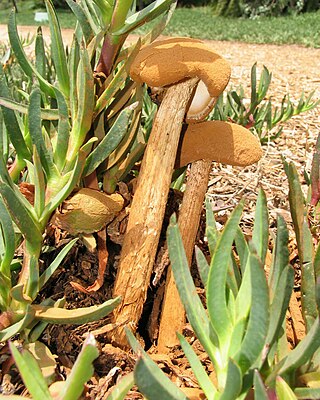
Battarrea phalloides is an inedible species of mushroom in the family Agaricaceae, and the type species of the genus Battarrea. Known in the vernacular as the scaley-stalked puffball, sandy stiltball, or desert stalked puffball, it has a woody, slender, and shaggy or scaly stem that is typically up to 40 centimeters (15.7 in) in length. Although its general appearance resembles an agaric with stem and gills, atop the stem is a spore sac, consisting of a peridium and a powdery internal gleba. In maturity, the spore sac ruptures to release the spores. Battarrea phalloides is found in dry, sandy locations throughout the world, and has been collected from Africa, Asia, Australia, Europe, North America, and South America. There is currently some disagreement in the literature as to whether the European B. stevensii is the same species as B. phalloides.

Cyptotrama asprata, commonly known as the golden-scruffy collybia or spiny woodknight is a saprobic species of mushroom in the family Physalacriaceae. Widely distributed in tropical regions of the world, it is characterized by the bright orange to yellow cap that in young specimens is covered with tufts of fibrils resembling small spikes. This fungus has had a varied taxonomical history, having been placed in fourteen genera before finally settling in Cyptotrama. This species is differentiated from several other similar members of genus Cyptotrama by variations in cap color, and spore size and shape.

Galerina sulciceps is a dangerously toxic species of fungus in the family Strophariaceae, of the order Agaricales. It is distributed in tropical Indonesia and India, but has reportedly been found fruiting in European greenhouses on occasion. More toxic than the deathcap, G. sulciceps has been shown to contain the toxins alpha- (α-), beta- (β-) and gamma- (γ-) amanitin; a series of poisonings in Indonesia in the 1930s resulted in 14 deaths from the consumption of this species. It has a typical "little brown mushroom" appearance, with few obvious external characteristics to help distinguish it from many other similar nondescript brown species. The fruit bodies of the fungus are tawny to ochre, deepening to reddish-brown at the base of the stem. The gills are well-separated, and there is no ring present on the stem.
Clarkeinda is a genus of fungi in the family Agaricaceae. According to the Dictionary of the Fungi, the widespread genus contains five species. Species in this genus, especially Clarkeinda trachodes, are only distributed in south Asia and southeast Asia.
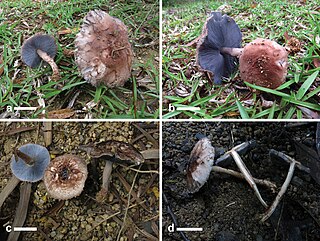
Heinemannomyces is a fungal genus in the family Agaricaceae. This is a monotypic genus, containing the single species Heinemannomyces splendidissima, which was defined in 1998 by Roy Watling. It is found in peninsular Malaysia and China.

Xanthagaricus is a genus of fungi in the family Agaricaceae. The genus contains 23 species found in India, Sri Lanka, Bangladesh, Thailand, China and Africa. Originally described in 1984 by Belgian mycologist Paul Heinemann as Hymenagaricus subgen. Xanthagaricus, it was promoted to generic status in 1997.

Macrocybe is a genus of fungi in the family Callistosporiaceae. Basidiocarps are agarics and were previously referred to Tricholoma, but are all large, whitish, and saprotrophic. Recent molecular research, based on cladistic analysis of DNA sequences, has shown that the genus is a natural, monophyletic grouping, though the status of several species is uncertain. Macrocybe species have a tropical to subtropical distribution.

Pholiota flammans, commonly known as the yellow pholiota, the flaming Pholiota, or the flame scalecap, is a basidiomycete agaric mushroom of the genus Pholiota. Its fruit body is golden-yellow in color throughout, while its cap and stem are covered in sharp scales. As it is a saprobic fungus, the fruit bodies typically appear in clusters on the stumps of dead coniferous trees. P. flammans is distributed throughout Europe, North America, and Asia in boreal and temperate regions. Its edibility has not been clarified.

Marasmius rotula is a common species of agaric fungus in the family Marasmiaceae. Widespread in the Northern Hemisphere, it is commonly known variously as the pinwheel mushroom, the pinwheel marasmius, the little wheel, the collared parachute, or the horse hair fungus. The type species of the genus Marasmius, M. rotula was first described scientifically in 1772 by mycologist Giovanni Antonio Scopoli and assigned its current name in 1838 by Elias Fries.
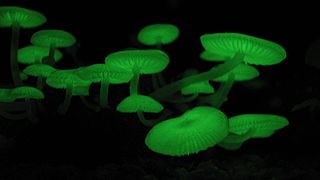
Mycena chlorophos is a species of agaric fungus in the family Mycenaceae. First described in 1860, the fungus is found in subtropical Asia, including India, Japan, Taiwan, Polynesia, Indonesia, and Sri Lanka, in Australia, and Brazil. Fruit bodies (mushrooms) have pale brownish-grey sticky caps up to 30 mm (1.2 in) in diameter atop stems 6–30 mm (0.2–1.2 in) long and up to a millimeter thick. The mushrooms are bioluminescent and emit a pale green light. Fruiting occurs in forests on fallen woody debris such as dead twigs, branches, and logs. The fungus can be made to grow and fruit in laboratory conditions, and the growth conditions affecting bioluminescence have been investigated.
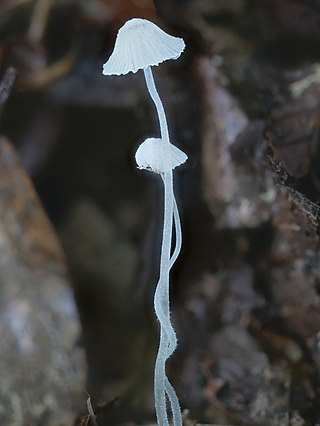
Mycena alphitophora is a species of agaric fungus in the family Mycenaceae. Its small, white, delicate fruit bodies are characterized by the powdery coatings on the surfaces of both the cap and stipe. The stipe base is not swollen or disk-like. The stipe surface is more hairy than Mycena adscendens.
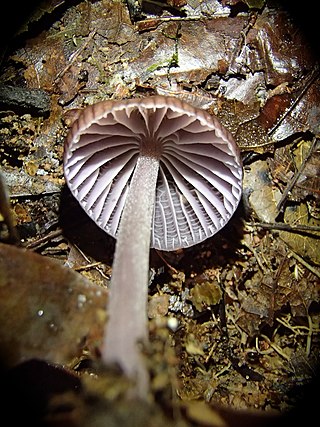
Mycena holoporphyra is a species of agaric fungus in the family Mycenaceae. It was first described by Miles Joseph Berkeley and Moses Ashley Curtis in 1868 as Agaricus holoporphyrus. Rolf Singer transferred it to the genus Mycena in 1962, where it is classified in the section Calodontes. First described from Cuba, it is also found in Trinidad, Africa, Mexico, and Central America and South America.Nicolas Niveirio, Orlando F. Popoff, and Edgardo O. Alberto, classify Mycena Holoporphyra for their distinguishable basiodiocarps that are violet or purple, having a radish like smell, fungal tissues, and a lack of pleurocystidia. In addition, Pegler, describes the species as having a pale cream spore print with spores of ellipse cylindrical to oblong cylindric, hyaline and deeply amyloid.

Sarcodon thwaitesii is a species of tooth fungus in the family Bankeraceae. It is found in Asia, Europe, and New Zealand, where it fruits on the ground in mixed forest.

Macrocybe crassa is a species of fungus that is native to Sri Lanka, India (Kerala), Thailand and Malaysia. The large pale cream to brownish mushrooms can weigh up to 1.25 kg and have 40 cm diameter caps. They are widely consumed and highly regarded.

Termitomyces eurrhizus species of agaric fungus in the family Lyophyllaceae native to Pakistan, India, Sri Lanka, Burma, southwestern China and Malaysia. The fungus has a symbiotic relationship with termites, its mushrooms growing out of mounds after periods of rainfall. It is eaten in Malaysia and the Indian subcontinent.
References
- ↑ "GSD Species Synonymy: Clarkeinda trachodes (Berk.) Singer". CAB International. Retrieved 2015-10-10.
- 1 2 Hosen MI, Ge ZW (2011). "Clarkeinda trachodes (Agaricales, Basidiomycetes), first record from Bangladesh". Mycotaxon. 118: 331–336. doi: 10.5248/118.331 .
- 1 2 Yang ZL (1991). "Clarkeinda trachodes, an agaric new to China". Acta Botanica Yunnanica. 13: 279–282.
- ↑ Leelavathy KK, Zachariah S, Sankaran KV (1981). "Clarkeinda trachodes, -an agaric new to India". Mycologia. 73 (1): 204–207. doi:10.2307/3759637. JSTOR 3759637.
- ↑ Pegler DN (1985). "The genus Clarkeinda trachodes (Basidiomycotina: Agaricaceae)". Botanical Journal of the Linnean Society. 91: 245–252. doi:10.1111/j.1095-8339.1985.tb01148.x.
- ↑ Berkeley MJ (1847). "Decades of fungi. Decade XV-XIX. Ceylon fungi". London Journal of Botany. 6: 479–514.